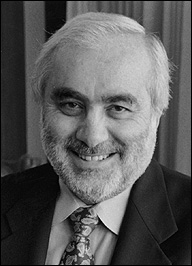![]()
Departments
![]()

|
Week of 9 April 1999 |
Vol. II, No. 30 |
Feature Article
Advances in cerebral palsy research
Award-winning director's center probes mysteries of motor control
By John Bishop
When Carlo De Luca directed the NeuroMuscular Research Laboratory at Children's Hospital in Boston from 1980 to 1984, he saw hundreds of children affected by cerebral palsy.
The disorder, usually caused by brain damage that occurs before or during birth, affects half a million Americans to varying degrees. Some have difficulty with fine motor tasks, such as writing or using scissors. Others are burdened with profound handicaps -- inability to speak, walk, or digest food properly -- and need extensive lifelong care.
"At Children's Hospital I started thinking about adapting technology to be used with children suffering from cerebral palsy," says De Luca, founder and director of Boston University's NeuroMuscular Research Center (NMRC), whose mission is to increase knowledge of motor control and improve the quality of health care for neuromuscularly impaired patients.
It is De Luca's pioneering work in this field that prompted the United Cerebral Palsy Research and Educational Foundation to honor him for "advances in the development and utilization of technology to improve the quality of life of persons with cerebral palsy and other disabilities," according to UCP Medical Director Murray Goldstein. On April 17 in Nashville, Tenn., De Luca will accept the foundation's 1999 Isabelle and Leonard H. Goldenson Technology Award at the annual meeting of the United Cerebral Palsy Associations.
|
|
|
Carlo De Luca |
He and his team at BU use EMG (electromyogram) measurements in their research on muscle activity. They have been able to make the electric signal sensors used on children smaller and less invasive. Putting surface-detecting probes on the muscles -- similar to what's done for an EKG on the heart -- is painless. The same cannot be said for the traditional way of probing muscles: using thin needles with sensors at the tips.
"Our technology allows researchers to look at some of those electrical signals -- not all of them -- outside the skin, without puncturing the skin and the muscle," De Luca says.
There is no cure for cerebral palsy, but physical therapy, drugs to control seizures and spasms, surgery, and mechanical aids can improve a patient's capabilities. Still, finding problem muscles that need correction is no easy task: walking two strides with a normal gait takes more than 30 major muscles working at exactly the right time and force.
Much of De Luca's work has been done with people who don't have cerebral palsy, because the characteristics of a healthy electrical signal are vitally important. "We have to understand how it works when it works well," he says. "If we don't, we can't fix it when it's broken."
BU's support has been essential to the re
